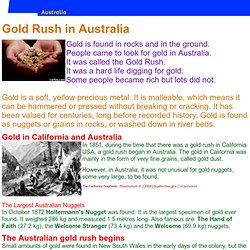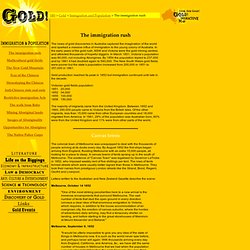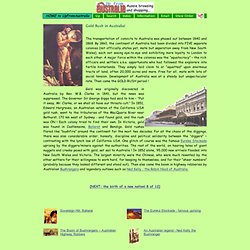

Gold! Gold Rush in Australia Gold is found in rocks and in the ground.

People came to look for gold in Australia. It was called the Gold Rush. It was a hard life digging for gold. Some people became rich but lots did not. Gold is a soft, yellow precious metal. Gold in California and Australia In 1851, during the time that there was a gold rush in California USA, a gold rush began in Australia. However, in Australia, it was not unusual for gold nuggets, some very large, to be found. The California Goldfields. The Largest Australian Nuggets In October 1872 Holtermann's Nugget was found.
The Australian gold rush begins Small amounts of gold were found in New South Wales in the early days of the colony, but the authorities hushed it up. Within a week there were over 400 people digging there for gold, and by June there were 2000. Between 1851 and 1861, Australia produced one third of the world's gold. ~ GOLD ~ The news of gold discoveries in Australia captured the imagination of the world and sparked a massive influx of immigration to the young colony of Australia.

In the early years of the gold rush, NSW and Victoria were the gold mining centres and attracted thousands of hopeful diggers. In March 1851, Victoria’s population was 80,000, not including Aborigines. By 1854 the population tripled to 237,000 and by 1861 it had doubled again to 540,000. The New South Wales gold fields were poorer but the state’s population increased from 200,000 in 1851 to 357,000 in 1861. Gold production reached its peak in 1853 but immigration continued until late in the decade. Victorian gold fields population: The majority of migrants came from the United Kingdom. Canvas towns The colonial town of Melbourne was unequipped to deal with the thousands of people arriving at its docks every day.
Letters written to the Australian and New Zealand Gazette describe the scene: Melbourne, October 14 1852 Credits. Australian Gold Rush: 1850. The bonanza in California was only the beginning.

An Australian named Edward Hammond Hargraves, who had been there, was certain that the same geological features were to be found in his own country. Returning on the boat from California late in 1850, he predicted that he would find gold within a week. 'There's no gold in the country you're going to and if there is, that darned Queen of yours won't let you touch it,' a fellow passenger told him. 'There's as much gold in the country I'm going to as there is in California,' snapped Hargraves, 'and Her Gracious Majesty the Queen, God bless her, will appoint me one of her Gold Commissioners.' Hargraves was right. The news of the fresh gold field reached England, along with the first gold, aboard the Thomas Arbuthnot. In fact, Hargraves had touched only the fringe of Australian gold. Other secondary rushes followed. Gold Rush in Australia! The transportation of convicts to Australia was phased out between 1840 and 1868.

By 1860, the continent of Australia had been divided into FIVE separate colonies (not officially states yet, mate but seperation away from New South Wales), each not seeing eye-to-eye and exhibiting more loyalty to London to each other. A major force within the colonies was the “squatocracy” – the rich officers and settlers a.k.a. opportunists who had followed the explorers into fertile hinterlands. They simply laid claim to or “squatted” upon enormous tracts of land, often 20,000 acres and more. Free for all, mate with lots of social tension. Development of Australia was at a steady but unspectacular rate. Gold was originally discovered in Australia by Rev. [NEXT: the birth of a new nation!